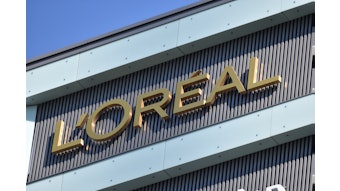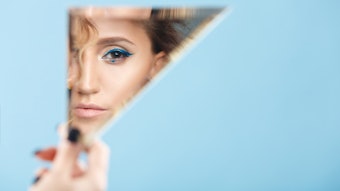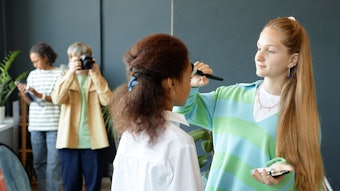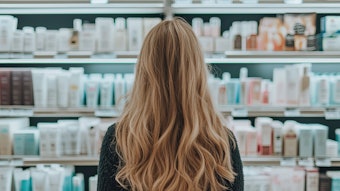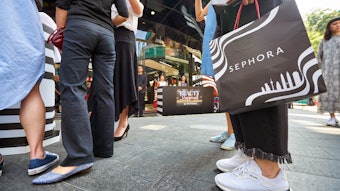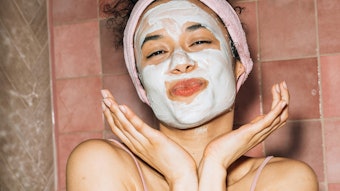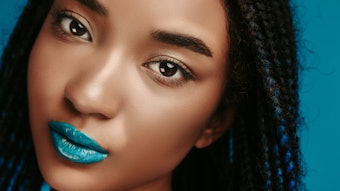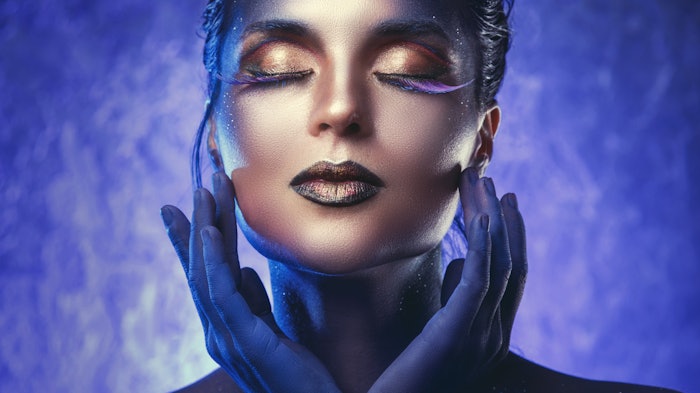
Editor’s note: This report navigates the dynamic world of color cosmetic trends, spotlighting innovative formats and cutting-edge ingredient technologies. In addition, it highlights expert insights from various market analysts; Alison Wery, assistant lecturer at the University of Toledo; Camille Desperiez, marketing project leader of Silab; Anushka Nadkarni, product development and innovation lead, and formulation scientist at Bentley Labs; Kelly Dobos, a consulting cosmetic chemist and adjunct professor at the University of Cincinnati; Sue Wilcock, beauty product development manager at Primark; and Joshua Britton, Ph.D., founder and CEO of Debut.
Early in 2025, Google Trends reported a 650% boost in searches for unrecognizable or catfish makeup. Digging deeper revealed this trend refers to applying makeup so well that you don't look like the same person. Per Bustle, people do it to entirely transform their look or mood – or “when they feel like ‘catfishing’” – i.e., assuming a false identity.1
Global Cosmetic Industry reported that color cosmetics in 2025 are being shaped by dual forces: fun and functionality. This includes blingy eye makeup, according to Spate and Google data, as well as colored and glitter mascaras, glitter freckles and peel-off lip liners/stains.2
“As has been the case for more than a year, lip products were the top category performers, increasing 19% on the strength of hybrid products with color payoff (fun) and skin care benefits (functionality),” Global Cosmetic Industry added. “Leading lip formats included oils and balms.”2
Lip Color Goes Long and Deep
In recent years, color cosmetics have consistently featured two superstar categories: lips and blush.3 Spate’s 2025 trend forecast highlighted several key search trends that could drive further growth in the lip category, noting gains in queries for brown and “dark” lip liners, as well as peel-off lip stains.
Indeed, in February 2025, Exploding Topics reported a whopping 1,329% increase in searches for the brand Wonderskin over the past two years.4 Renowned for its Peel & Reveal Lip Stain Masque, the brand’s three-step lip color application process is claimed to last 10+ hours. It is Amazon’s top-selling lip stain, generating an estimated $1.9 million in monthly revenue, and it has prompted 8,000+ #wonderskinlipstain posts on TikTok.3
In addition to lip stains, peel-off lip liners are drawing interest. The same source recorded a 9,800% search increase in just two years, with brands like Sacheu up 279% in search volume.3
Beyond the physical limits of color, brands like Kosé Corp.’s Decorté are tapping into color theory and biology for inspiration.5 Recent headlines highlighted the brand’s Rouge Decorté Cream Glow lipstick, which was released on Jan. 16, 2025. Google Trends recorded a 150-300% increase in searches for the product within two weeks of the launch.
The product is reportedly designed to “enhance skin and facial structure.” The Japanese beauty news source VoCe explained,6 "[the products are] based on a unique color theory that focuses on naturally blending the difference between the complexion of the skin and lips. [T]he colors derived from the complexion of the skin and lips blend in with the impression of the face, creating a naturally lively expression."
What's more, the products have a smooth, silky texture and are designed to melt at body temperature. "The more you apply it, the more your mind will relax," VoCe noted, giving a mind-body "spin" to the collection.
Formulated with the company's proprietary skin care Liposome Technology, including hyaluronic acid, ceramides, vitamin E and Shirakaba Water (white birch), the product is said to leave lips soft and supple while the color capsule ensures lasting, vibrant color and a smooth finish.
These last points in terms of texture and benefits are critical. In its January 2025 report, the Benchmarking Co.7 revealed consumers indicated the most important considerations of making a color cosmetic purchase are: finish and texture (88%), long-wear (83%), type of coverage (82%), the applicator/application method (67%), ingredient profile (60%) and ability to multitask (59%); although notably, 93% indicated shade match was most important.
Blush Formats Get Cheeky: Jellies, Tints and Balms
A December 2024 report from Spate’s New Popularity Index, combining Google and TikTok data, points to jelly blush formats as a standout trend.3 These “vibrant blush stains with a jelly, elastic texture," as Spate put it, are typified by Milk Makeup’s Cooling Water Jelly Tint, which has massive search volume and TikTok popularity.
Alison Wery, assistant lecturer at the University of Toledo's Department of Pharmacy Practice, described this product in March 2024. "This product is all about texture, led by the inclusion of agarose, a purified version of agar that is, interestingly, a popular gelling agent used in microbiology to grow microorganisms in petri dishes. The polysaccharide is extracted from red seaweed that, when heated and cooled, becomes a solid and squishy gel due to hydrogen bonding.” Milk Makeup’s Cooling Water Jelly Tint additionally includes carbomer, another gelling agent.
The prevalence of this unique formulation "indicates consumer openness to innovative textures and formats," Spate observed, "particularly those with a glossy finish."
Other formats are also favored in the cheek sector, namely tints. This format is more compatible than powder blushes and provides a "buildable watercolor effect," per Spate, imparting a "natural flush" that can be controlled by the wearer. The format is also multifunctional, allowing consumers to apply pigment to the lips, cheeks and eyelids.
A naturally flushed appearance is at the heart of the “workout blush” trend last fall, described by Editors Beauty8 as “rosy cheeks, dewy skin and the kind of glow that says, ‘I just crushed it in spin class,’ – minus the actual sweat.” Essentially, workout blush is more like a flush than a blush and complements the no-makeup makeup look.
Workout blush is said to be an offshoot the “boyfriend blush” trend that went viral on TikTok last summer with more than 11 million videos, per Makeup.com by L’Oreal.9 Again, the technique involves applying blush under the cheekbones to mimic the look of a flush face – replicating the “outdoorsy effect of ruddy cheeks after a game of rugby or polo,” which per Glamour UK, is how it picked up its name.10
As Sue Wilcock, beauty product development manager at Primark put it, "The 'workout blush' look allows you to achieve the natural rosy glow that comes along with exercising without the sweat, and perfectly complements the no-makeup makeup looks that are always in style. The technique for this look involves applying blush under the cheekbones to mimic the look of a flush face after exercising. It’s a great style for those natural beauty looks for a casual yet statement-making moment. It’s all about a soft, warm and diffused finish."
She added that equally as important as blush color is the texture, as powder blushes tend to give more of a matte look depending on whether they have any shimmer, and cream blushes give a healthy glow.
Another recent trend in blush formats is the blush balm, which according to Exploding Topics,11 has increased 80% in the past two years. This product can be described as a type of cream blush designed to "melt into the skin." Such products are intended for easy application, offer additional nourishing properties and provide a natural, radiant look with minimal effort.
One example is About-Face's Cheek Freak Blush Balm, described as lightweight and ultra creamy, gliding onto skin for buildable coverage. Per the company, the "transformative, cushiony formula melts onto skin for a diffused, natural finish." The product includes hyaluronic acid and meadowfoam seed oil to nourish skin.
Laying the Foundation: Serums and Sticks
Consumer interest in novel product forms extend beyond cheeks and lips. Searches for tinted serums are up 1,280% in the past five years, per Exploding Topics.12 These provide light coverage and care benefits such as hydration and nourishment, plus actives such as hyperpigmentation correction; examples including moisturizer, facial sunscreen and lip balm. Per Exploding Topics, tinted serums are part of the "tinted skin care" meta trend of cosmetics that provide skin-enhancing properties and subtle coverage. They are reportedly becoming increasingly popular with the “makeup-free” look.
Then there are stick-form beauty products. They’ve been around from the beginning but are back in vogue thanks to their versatility, mobility and multifunctionality. Market Research Intellect projects13 the contouring sticks market will reach US $2.2 billion by 2031, increasing at a 8.2% CAGR (2024 - 2031). The same source also expects blush sticks will expand to $6.18 billion by 2032, growing at a CAGR of 10.36% (2025 to 2032).
Why Consumers Are Embracing New Product Forms
Camille Desperiez, marketing project leader of Silab, provided her take on what’s driving consumer interest in novel product formats. “The diversification of forms significantly influences the evolution of consumer experience, not only in terms of practicality, but also in terms of product perception and the impact on well-being resulting from its sensoriality,” she wrote.
“Recently, we have seen several launches in sticks. Whether serums, sun care or moisturizing blush, this nomadic and hands-free form is easy to apply and offers the possibility of carrying out ‘beauty touch-ups’ during the day.”
She added that cosmetic patches can offer targeted solutions. “[These] meet the trend of personalization and spa-at-home, such as eye masks, patches for pimples or localized treatments. They are easy to use, allow targeted absorption of active ingredients and can be inspired by the trend of aesthetic medicine.”
Looking ahead, Desperiez sees future potential in product forms concentrated in science-backed active ingredients that offer “an unusual sensory experience and multifunctional benefits” and continue to gain ground.
“Brands are currently taking advantage of the craze surrounding the sophistication of body products to develop new innovations that are inspired by the technicality and forms developed for facial care,” she explained, adding, “forms whose textures and appearance evolve during application appeal to consumers who are looking for surprises and who want to make their beauty routine even more sensorial and unique.”
Enabling these experiences are innovations such as Silab’s Silafilm ingredient, a natural, biodegradable dry film highly concentrated in active ingredients. “Activated in contact with water, this functional support rapidly and intensely releases active molecules deep down in the skin,” Desperiez concludes.
Emerging in Eyes: Baby Fat and Creaseless Concealer
The boom in the cheek and lip categories isn’t the whole story, however. Spate’s 2025 trend forecast3 also pointed to a select resurgence in eye segments, as well as unmet concerns that could drive product innovation and marketing initiatives for brands in 2025 and beyond.
For one, Spate data points to simplicity in the eye area, as evidenced by strong growth forecasts for brow stains and tubing mascaras. At the same time, however, maximalist shoppers are forecast to pursue cluster lashes.
Other novel eye area concepts and claims are also driving innovation. For example, aegyo-sal is a Korean term referring to the “baby fat” beneath one’s eyes, which in some cultures is viewed as a sign of youth. In its 2025 predictive report, Spate anticipates that Google searches for aegyo-sal will grow 134.7% between September 2024 and September 2025.
Google search data between December 2023 and 2024 also showed that one brand dominates aegyo-sal queries: Colorgram’s All In One Aegyo-Sal Maker. Available in seven colors, the Korean brand’s dual-ended contour stick features a “shimmery side to highlight your under-eye area,” as well as a flat matte side to add “subtle shading” to give the illusion of the sought-after pouches, which in turn are said to evoke a sense of larger eyes.
Another eye-area makeup concern drawing attention – and face in general, really – is creasing, which aligns with the crepey skin phenomenon we saw several years ago. Last August, Google Trends reported searches on Tarte Cosmetics went up 80% in one week shortly after the brand’s June launch of its Creaseless Creamy Concealer.
The concealer is formulated so as not to crease, break down and settle into fine lines, per the company.14 Its natural, non-cakey finish also effectively covers dark circles, redness, blemishes, hyperpigmentation, etc., and leaves skin hydrated, per the company.
Creaseless Cosmetics Explained
Anushka Nadkarni (AN), product development and innovation lead, and formulation scientist at Bentley Labs, recently shared her insights on creaseless cosmetics with C&T.
C&T: What kinds of makeup products are now claiming "creaseless" effects? What does this mean? What's driving this claim? Is this just another way to say crepey skin?
AN: There are quite a few in the market - concealers, eyeshadows, eyeshadow primers, setting spray and setting powders. They are focused on achieving a flawless, long-wearing “glass skin” effect — essentially smoothing out lines, preventing creasing and maintaining a uniform finish. I do believe anti-crepey and anti-creasing go hand-in-hand.
C&T: What technologies help to create this effect? What are the actual "mechanisms” that create this effect?
AN: Combining immediate optical blurring with long-term skin benefits is a smart approach. Silicas and soft-focus powders will give that instant diffused look, while elastin-boosting actives help improve skin texture over time. These could help maintain the “untouched” effect throughout the day.
C&T: How might one test for this sort of benefit from a cosmetic?
AN: Since the concept of creaseless makeup is so visually driven, consumer perception and photographic evidence would likely be the strongest validation tools. High-resolution imaging, before-and-after comparisons and even video wear tests under different lighting conditions could be key for demonstrating effectiveness.
For instrumentation, something like PRIMOS (Phase Shift Rapid In Vivo Measurement of Skin) or the Cutometer could be useful to quantify skin roughness reduction and elasticity improvement over time. Skin D-Squame analysis might also help to track any smoothing effect on texture.
C&T: What types of physical challenges does the formulator face when creating a "creaseless" cosmetic product?
AN: Pushing the levels of silica and clays too high can lead to dryness, patchiness or even pilling, especially if not well-balanced with emollients or film-formers. The challenge is achieving enough oil absorption and blurring without crossing into a powdery, heavy finish.
Also, the balance between volatile and non-volatile components in the formula could be key — too many volatiles, and you risk a dry-down that accentuates texture but too few, and it might not set well.
Color Innovations: Metal-free, Sustainable and Sensorial Launches
Although pigments and colorants have continuously received makeovers, a peek behind the scenes reveals recent launches support formulators with a novel twist. Take EMD Electronics’ latest launch, for example.15
Metal-free metallics: The Ronaflux metal-free high-performance metallic cosmetic pigments are designed to act as a chroma intensifier without diluting color saturation, per the company. Their striking color effects reportedly cannot be recreated by blending other pigments, which can make them difficult to replicate by competing brands.
“Our new Ronaflux pigments are completely unlike any other type of pigment in the personal care market," said Mike Blazejowski, vice president of the Americas. "They are made differently, they behave differently and they provide dramatic effects that can’t be found anywhere else. They are the biggest innovation in pigment technology in 20 years.”
Qinyun Peng, the company’s head of application technology for the Americas, added, “One thing that I really appreciate as a formulator is that the Ronaflux pigments help the creation of striking color effects consistently over different skin tones, making [each] a universal color for all. This translates into saving time and money because the effects are so consistent.”
Biodegradable glitter and butter-coated powders: From a sustainability standpoint, Blue Sun introduced16 a biodegradable glitter and butter-coated powders to combine innovation and sustainability in high-performance cosmetic applications. The Bioglitter range, created from eucalyptus cellulose, offers a sustainable alternative to microplastic-based glitters and is fully compliant with EU 2023-2055 microplastic regulations. It reportedly works across a wide range of product types, including water-based, oil-based and alcohol-based systems, as well as nail polishes and soaps. It also biodegrades naturally in environment.
In addition, Blue Sun's butter-coated powders, engineered for eco-friendly and vegan products, include offerings based on seven powders: a mica/kaolin/barium sulfate blend, barium sulfate, kaolin, mica, talc, starch and synthetic mica. The latest addition, Butterpowder Gel supports mousse-like textures with a velvet feel and matte finish. Applications include primers, eyeshadows, liquid-matte lipsticks, foundations and cream blushes. It reportedly offers reliable thixotropic viscosity and pigment suspension across diverse viscosity ranges, with use levels varying from 3-5% in emulsions to 15-80% in color formulations.
Vegan yet vibrant: Vegan yet vibrant was the focus of Eckart's Syncrystal Very Berry pigment launch,17 which is said to deliver a carmine-free pink effect for pink or violet colors in water-based formulations, eye products and vegan cosmetics. The effect pigment features a soft texture, bright colors and high purity, per the manufacturer, and consists of pure synthetic fluorphlogopite flakes, which are responsible for the soft feel, vibrant color and extremely high purity.
The company also recently launched Syncrystal Garnet for red and purple shades.18 "Our new addition fills the gap with more blue and less yellow, for a scarlet-red effect," the company reports. The ingredient is said to feature exceptional brilliance and hiding power, impressive chroma and a pronounced pearlescent effect. The carmine-free pigment is based on synthetic fluorphlogopite flakes and is also said to impart excellent skin feel and high color purity, especially compared to natural mica-based pigments.
How Makeup and Colorants Are Evolving
It’s interesting to note the key claims and functionalities these recent launches highlight; especially sustainable and vegan properties. To give us a broader view of these shifts in color cosmetics and colorants, we turned to industry expert Kelly Dobos (KD), a consulting cosmetic chemist and adjunct professor at the University of Cincinnati.
C&T: How have color cosmetics changed in recent years? What's different about their formulations and/or functions?
KD: Color cosmetics have undergone significant changes in recent years, evolving to meet consumer demands for multifunctionality, customization and more skin-friendly formulations. Brands are creating very innovative hybrid products. Many foundation products today now incorporate skin care benefits but there’s a lot of room for innovation in eye and lip categories.
C&T: How have colorants changed in recent years? What new sources are being used to create pigments?
KD: There’s a lot of innovation in composite pigments that produce spectacular effects through structure interference. Structural interference colors in cosmetics are based on the principles of light interference and diffraction, rather than traditional absorption-based color pigments. These interference colors are produced by nanoscale structures that interact with light waves, creating vibrant iridescent, metallic effects and striking color travel effects.
Currently, these types of effects are based on mica, synthetic mica or borosilicate substrates. New technologies are being developed that involve growing biodegradable cellulose into nanostructures that reflect light.
C&T: How are regulations impacting color cosmetics?
KD: Color additives for cosmetics are regulated in every country and region around the world and those regulations can differ substantially from one another. If you add regional or retailer-specific ingredient restrictions to this, creating globally acceptable formulations can get pretty complicated.
[To me], one of the biggest challenges for color cosmetics is replacing cyclic silicones. While alternatives have been proposed, they often fall short in fully replicating the functionality of cyclic silicones. This remains a significant challenge for formulators, requiring extensive research and testing, and ultimately might result in potential compromises on certain performance aspects.
C&T: How do you think color cosmetics and/or their ingredients will evolve in the future? What opportunities are untapped?
KD: Biotech continues to revolutionize the way cosmetic ingredients can be produced. Color additives for cosmetics are regulated in every region around the world and those regulations can vary considerably; and a big challenge for beauty has been finding a globally acceptable true red pigment that can be used in the eye area.
Carmine can be used but it’s traditionally been sourced from beetles so it’s not considered vegan and it can cost significantly more than synthetic organic reds. Recently, Debut has succeeded in creating a bio-derived carmine but the biggest hurdle will be getting this color approved by the U.S. FDA and other regulatory agencies across the globe, as currently only the beetle-derived material is listed for use in cosmetics. (Editor’s note: For more on Debut’s ingredient, keep reading).
If things go well, I think we’ll see more sustainable sources for other existing colors before truly new color molecules. A plant derived from carbon black would be pretty nice to have!
Color Pigments from Beyond
Moving makeup forward, two recent technologies have emerged from unexpected sources that brighten color cosmetic prospects especially in terms of sustainability; and no doubt there are others.
Tech transfer from textiles: Vividye, a Swedish deep-tech startup, has adapted its environmentally friendly textile dyes to cosmetics.19 According to the company, unlike traditional dyes, whose small molecules penetrate materials, Vividye’s functionalized pigments are larger particles, designed to adhere to surfaces without dissolving in water.
"Traditionally, modifying the characteristics of pigments has involved coating them in polymer films, essentially plastics," the company website explains. "Our technology eliminates the need for plastics, resulting in a completely plastic-free solution."
Per the company, the heart of its technology lies a fusion of "groundbreaking" surface chemistry and precision engineering. "We specialize in meticulously modifying pigment properties, tailoring them to meet specific application needs. This involves enhancing characteristics such as color intensity, durability and versatility, revolutionizing the way pigments are utilized," the company website states.
Since its founding in 2020, Vividye has focused on the safe and sustainable coloring of textiles. "Moving into cosmetics felt like a natural next step," said Johanna Nissén Karlsson, CEO of Vividye. "The cosmetics industry faces distinct challenges, including stringent regulatory demands and high consumer expectations for product safety and environmental sustainability. Our technology offers a better alternative to traditional dyes, and we’ve seen a growing need for this in products that people use on their skin and hair..."
Biotech breakthrough for carmine: As Dobos mentioned in a previous section, the biotech-driven Debut has achieved a significant scientific breakthrough20 in creating biotech-derived carmine, the intensely red pigment widely used in color cosmetics. Until now, it has been harvested from crushed cochineal beetles or derived from synthetic processes that are not a 100% performance match of natural carmine. Debut will be biomanufacturing this new, animal-free carmine molecule for beauty – an industry first – soon to be followed by food and beverage.
According to the company, carmine is one of the most difficult molecules to innovate. Many scientists have tried but synthetic/vegan alternatives to carmine are not precise color matches with the same vibrancy, stability and formulation potential. Debut’s biomanufactured carmine is said to offers all the brilliance of natural carmine minus the myriad of health, safety and environmental concerns.
C&T recently connected with Joshua Britton, Ph.D. (JB), founder and CEO of Debut, to get his take on the impact of this innovation.
C&T: First of all, why the focus on carmine? Was the original intent to reproduce the pigment or was this more serendipity?
JB: Discovering a replacement to natural carmine, which is derived from the cochineal beetle, is long overdue. Many, many years overdue, in fact. Scientists have tried hard to find a biotech-derived replacement for over 15 years, with little success. At Debut, we knew we had to rise to the challenge and be the ones to conquer carmine, a highly complex molecule that has eluded innovation until now.
It was unfathomable to us that the choice for brands, when it came to coloring product forms with a red pigment, was either harvesting the cochineal beetle (70,000 cochineal beetles are needed to produce one pound of crushed dried insect and a fifth of a pound of carminic acid) or using inferior synthetic replacements that are no match for natural carmine’s vibrancy, stability, staying power and formulation potential.
Beyond beauty, the need for a carmine replacement extends to food, beverages and textiles. Debut’s biomanufactured carmine offers unparalleled health, safety, animal-free and environmental advantages. It is more than 95% pure versus the industry average of 30% or lower; the purity of carmine derived from the cochineal beetle is low, typically 10%.
Biomanufactured carmine is also devoid of a specific protein found in beetle-derived carmine that is known to cause skin irritation, making it highly beneficial for food and beauty applications. Bio-carmine also boasts antioxidant and anti-inflammatory properties.
C&T: How was the molecular structure replicated? Was AI behind it? And what kind of biotech was employed?
JB: Our scientific breakthrough came in the form of innovating new families of enzymes responsible for key steps in the bioproduction process. Our bio-carmine is the exact same molecule as natural carmine minus the questionable environmental and ethical practices. Our molecule has the same chemical structure and the same spectrographic properties, and it is 100% biosynthesized.
It was important to us that we could show just how advanced our biotechnology platform is and take on the fabled carmine molecule given its complex poly aromatic structure with multiple oxidation events and a carbon-carbon glycosylation. It took us nearly four years, ten scientists and overturning multiple scientific barriers to replicate the molecule. We also had to overcome the use of an expensive input material that all others use and that allows us to reach cost parity, requiring some complex biochemistry and its translation to this ingredient. That’s a key part of the equation, and we are most proud of the result.
The only difference between Debut’s molecule and natural carmine is that ours has zero insect residue and common allergens, and it also has significantly higher purity – more than 95% purity compared to natural carmine’s 10% purity.
C&T: On what scale can the material be produced? What special processes are needed to scale it up?
JB: Debut’s carmine molecule is now available via animal-free biomanufacturing thanks to our ability to scale production of the molecule to pilot scale, enabling the formulation of bio-carmine for beauty applications. We have created enough volume to be formulated into customer prototype products and we are now in negotiations with a larger company to bring this to scale for the cosmetic industry first, and then nutrition.
C&T: Does the material perform equally in formulations? How has it been tested?
JB: We have actually formulated our bio-carmine versus insect-derived carmine and have found that the aesthetics and color are identical. Additionally, we have found that our carmine is slightly more vibrant due to its superior purity. In fact, due to the much higher purity of bio-carmine, you actually need to add less to the formulation in order to achieve the same aesthetic result.
C&T: Are additional pigment replacements being considered? What about those used in sun protection, for example?
JB: Carmine was our primary focus as far as pigments are concerned because it is in such widespread use across beauty and other industries, and there has been a complete absence of innovation with this molecule. At Debut, our innovation efforts are always focused on innovating high-performing actives, either bio-replacements or novel molecules, that raise the game in terms of product performance.
It also goes without saying that all our molecule innovations have sustainability and ethical practices built into the process. Our biomanufacturing process is more closely aligned with that of the pharma industry than beauty. We are now in discussion with some companies and exploring what other molecules we could biomanufacture using our advanced platform. As I’m sure you can imagine, there a quite a few examples!
C&T: Is this pigment subject to U.S. FDA pigment regulations and batch certification?
JB: Our ingredient falls under the established INCI for carmine, and we will be working to educate the FDA on bio-carmine. The FDA filing states that it comes from beetles, and thus even though it is the exact same molecule, we will have to work alongside the FDA to educate them on the bioprocess; namely that it yields the exact same molecule but at a higher purity, with a safer process, and resulting in a safer end-product.
Conclusions
Like any beauty product, innovation led by consumers insights and marketing vision is the key to creating breakthrough color cosmetics. From unique product formats to advanced ingredient technologies, brands are pushing boundaries to exceed consumer demands for performance and novelty. The integration of expert knowledge and data-driven innovation will be crucial for ensuring both the efficacy and appeal of new color cosmetic products.
References
1. Grabenhofer, R. (2025, Jan 24). 6 Trends in beauty: Rouge Decorté lipstick, 'unrecognizable' makeup, berry beauty, Numbuzin panthenol skin serum, etc. Cosm & Toil. Available at https://www.cosmeticsandtoiletries.com/research/consumers-market/news/22931529/6-trends-in-beauty-rouge-decort-lipstick-unrecognizable-makeup-berry-beauty-numbuzin-panthenol-skin-serum-etc
2. Global Cosmetic Industry. (2025, Feb 16). Makeup 2025: Skin care and indulgent fun (+2024 sales). Available at https://www.gcimagazine.com/brands-products/color-cosmetics/news/22933515/makeup-2025-skin-care-indulgent-fun-2024-sales
3. Global Cosmetic Industry. (2025, Jan 15). 2025's Makeup trends move beyond lips and blush. Available at https://www.gcimagazine.com/brands-products/color-cosmetics/article/22929454/2025s-makeup-trends-move-beyond-lips-blush
4. Grabenhofer, R. (2025, Feb 15). 9 Emerging beauty trends: Ultra-reflective, Aime Derm skin care, micronutrition, Wonderskin lip stain and more. Cosm & Toil. Available at https://www.cosmeticsandtoiletries.com/research/consumers-market/news/22933509/9-emerging-beauty-trends-ultrareflective-aime-derm-skin-care-micronutrition-wonderskin-lip-stain-and-more
5. Rouge Decorté. (Accessed 2025, Mar 7). Rouge Decorté Glow. Available at https://decortecosmetics.com/collections/lips/products/rouge-decorte-glow
6. VoCE. (Accessed 2025, Mar 7). Your skin will look beautiful the moment you apply it! Cosme Decorte's new, ultimate lip product that will appeal to everyone is now available [PR]. (Google translated from Japanese). Available at https://i-voce.jp/feed/3902786/
7. Herich, D. (2025, Mar 4).The rise of multipurpose skin care and makeup: Meeting consumer demand for versatility. Global Cosmetic Industry. Available at https://www.gcimagazine.com/ingredients/skin-care/news/22932586/the-rise-of-multipurpose-skin-care-makeup-meeting-consumer-demand-for-versatility
8. Editor's Beauty. (Accessed 2025, Mar 7). Flex your glow: How to master the workout blush trend. Available at https://www.editorsbeauty.com/home-2/get-the-glow-workout-blush-is-the-new-beauty-flex
9. Wax, S. (2024, Jul 15). What is boyfriend blush? How to master this viral blush trend. Makeup.com by L'Oreal. Available at https://www.makeup.com/makeup-tutorials/trends/boyfriend-blush-trend
10. Turner, E. (2024, Apr 1). Boyfriend blush is TikTok's coolest makeup trend. Glamour. Available at https://www.glamourmagazine.co.uk/article/boyfriend-blush
11. Grabenhofer, R. (2024, Aug 1). 7 Trends in beauty - Blush balm, Glaminatix Cosmetics, Aliona las serum and more. Cosm & Toil. Available at https://www.cosmeticsandtoiletries.com/research/consumers-market/news/22916558/7-trends-in-beauty-blush-balm-glaminatrix-cosmetics-aliona-lash-serum-and-more
12. Grabenhofer, R. (2024, Dec 20). 8 Trends in beauty searches: Kiko Cosmetics, mascara innovation, hair peptide serum, matcha perfume and more. Cosm & Toil. Available at https://www.cosmeticsandtoiletries.com/research/consumers-market/news/22929397/8-trends-in-beauty-searches-kiko-cosmetics-mascara-innovation-hair-peptide-serum-matcha-perfume-and-more
13. Market Research Intellect. (2025, Mar). Contour stick market size by product, by application, by geography, competitive landscape and forecast. Available at https://www.marketresearchintellect.com/product/global-contour-stick-market-size-and-forecast/
14. Tarte Cosmetics. (Accessed 2025, Mar 7). Creaseless creamy full-coverage concealer. Available at https://tartecosmetics.com/shop/creaseless-creamy-full-coverage-concealer-2971.html?srsltid=AfmBOoqMqjD2VYseBUccS0wL1zE5hqjHF2PXnG_GxQ4BlrRzGE_ZHD_3
15. Cosm & Toil. (2025, Feb 13). Say hello to Ronaflux: Metal-free metallic pigments redefining makeup innovation. Available at https://www.cosmeticsandtoiletries.com/cosmetic-ingredients/colorant/news/22932895
16. Cosm & Toil. (2025, Jan 29). Blue Sun innovates Bioglitter, Butterpowder, Bluecam ranges for sustainable performance. Available at https://www.cosmeticsandtoiletries.com/cosmetic-ingredients/formulating-aids/news/22932006/blue-sun-international-blue-sun-innovates-bioglitter-butterpowder-bluecam-ranges-for-sustainable-performance
17. Cosm & Toil. (2025, Jan 22). Eckart unveils carmine-free Syncrystal Very Berry for pink or violet cosmetic colors. Available at https://www.cosmeticsandtoiletries.com/cosmetic-ingredients/colorant/news/22931412/eckart-cosmetic-colours-llc-eckart-unveils-carminefree-syncrystal-very-berry-for-pink-or-violet-cosmetic-colors
18. Cosm & Toil. (2024, July 10). Eckart debuts Syncrystal Garnet high-chroma red, bluish undertone pigment. Available at https://www.cosmeticsandtoiletries.com/cosmetic-ingredients/colorant/news/22914515/eckart-cosmetic-colours-llc-eckart-debuts-syncrystal-garnet-highchroma-red-bluish-undertone-pigment
19. Cosm & Toil. (2024, Dec 17). Swedish tech startup Vividye adapts eco-conscious textile pigments to cosmetics. Available at https://www.cosmeticsandtoiletries.com/cosmetic-ingredients/colorant/news/22929035/vividye-swedish-tech-startup-vividye-adapts-ecoconscious-textile-pigments-to-cosmetics
20. Cosm & Toil. (2025, Feb 25). Debut revolutionizes beauty with animal-free carmine breakthrough. Available at https://www.cosmeticsandtoiletries.com/cosmetic-ingredients/colorant/news/22934257/debut-revolutionizes-beauty-with-animalfree-carmine-breakthrough


